Prairie Dog Madness!
Hornady Brings Superformance Ballistics to Varmint Hunters
by Paul Helinski
GunsAmerica Blog
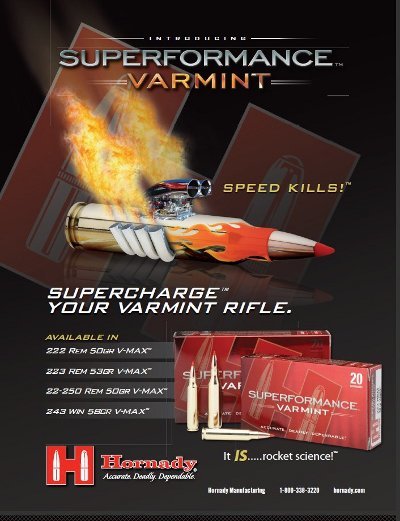 You don’t hear “game changer” much in the world of production ammunition. But once again, Hornady Manufacturing Co. has indeed changed yet another game. If you have ever considered hunting prairie dogs with your AR-15 platform rifle but thought the cartridge slightly underpowered for 300 yard dogtown decimation shots, you can now get close to .22-250 ballistics out of your .223 Remington chambered AR. The Superformance line of ammunition from Hornady now has a Superformance Varmint line (click here to download the PDF), and the possibilities that come from these “off the chart” new cartridges are truly amazing.
You don’t hear “game changer” much in the world of production ammunition. But once again, Hornady Manufacturing Co. has indeed changed yet another game. If you have ever considered hunting prairie dogs with your AR-15 platform rifle but thought the cartridge slightly underpowered for 300 yard dogtown decimation shots, you can now get close to .22-250 ballistics out of your .223 Remington chambered AR. The Superformance line of ammunition from Hornady now has a Superformance Varmint line (click here to download the PDF), and the possibilities that come from these “off the chart” new cartridges are truly amazing.
Superformance is not a new line from Hornady. In larger calibers it has been out for about a year and today, along with the announcement for this new Varmint line, Hornady announced the arrival of Superformance Match, including a whole new technology for bullet jacket uniformity called AMP™ (Advanced Manufacturing Process). The PDF for that one is here and we will be testing it on proof barrels for a future blog post or GunsAmerica Magazine article, but for today I am going to stick to the specifics of the Varmint.
First I’d like to back up a bit and explain some basics about what limits the performance of any cartridge, whether it is your .223 AR or your 9mm Glock. When a cartridge is adopted in a production firearm a set of physical attributes are registered with an umbrella organization called SAAMI (Sporting Arms and Ammunition Manufacturers Institute). When that data is registered, it not only records the physical dimensions of the cartridge, but also the maximum pressure the case head and walls of the brass cartridge will exert on the chamber walls around them for that specific named chambering (ie. .223 Remington, .300 Savage, 9mm Parabellum).
That pressure specification gives firearm manufacturers a hard and fast rule as to how tough the action of any firearm needs to be if you want to print that named cartridge moniker on the barrel and sell the gun as chambered for that specific cartridge. So while it may seem like a good idea to stuff as much of the fastest burning powder into your cartridge case as you can, in the world of real firearms you can’t do that because you might and probably will create unsafe pressures in your gun. SAAMI exists so that Hornady or anyone else can make ammunition for a Remington rifle and both companies will be on the same page for physical specs and pressure levels.
Gun powders have what is called a “burn rate” that identifies how fast they burn once ignited by the primer. As the solid powder ignites and turns to pressurized gas, it has a pressure curve, an acceleration of pressure, which causes acceleration of the bullet. It has a buildup, a peak and a drop off. How fast they burn controls this pressure curve, which falls off completely as the bullet leaves the barrel. If you use a powder that burns too fast you waste the time that the bullet is still in the barrel and that pressure and acceleration could still be building behind it. If you use a powder that burns too slow, the bullet leaves the barrel and the rest of the unburnt powder burns outside the barrel (which is why your 2″ .357 Mag has such a huge muzzle flash).
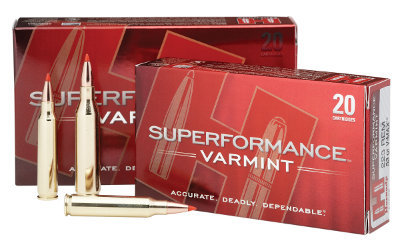 Hornady has taken these hard and fast rules of physics and squeezed every last bit of performance out of single given cartridge and bullet combinations. They call it Superformance, and when you look at the numbers, it really is “super-performance.” Hand loaders have been trying for years to squeeze more performance out of the .223 Remington, and the .243 Winchester, and for that matter, pretty much every cartridge we have out there. There have been “wildcat” modifications to many calibers that seemingly get more performance out of a similar but different shaped package, but wildcats aren’t within SAAMI specifications and cannot be used in a gun labeled for a standard caliber. Even worse, because wildcats don’t have a SAAMI specification, they can vary a great deal from gun to gun because there is no oversight of what the cartridge designation consists of even in terms of overall length, rim thickness, shoulder angle, or any other critical specification for production ammunition. So if you want to stay within a specific pressure tolerances for a given cartridge designation, we have to use the reloading manual. The “max load” in the reloading manual is the limit for that caliber, and that is the most performance you will get.
Hornady has taken these hard and fast rules of physics and squeezed every last bit of performance out of single given cartridge and bullet combinations. They call it Superformance, and when you look at the numbers, it really is “super-performance.” Hand loaders have been trying for years to squeeze more performance out of the .223 Remington, and the .243 Winchester, and for that matter, pretty much every cartridge we have out there. There have been “wildcat” modifications to many calibers that seemingly get more performance out of a similar but different shaped package, but wildcats aren’t within SAAMI specifications and cannot be used in a gun labeled for a standard caliber. Even worse, because wildcats don’t have a SAAMI specification, they can vary a great deal from gun to gun because there is no oversight of what the cartridge designation consists of even in terms of overall length, rim thickness, shoulder angle, or any other critical specification for production ammunition. So if you want to stay within a specific pressure tolerances for a given cartridge designation, we have to use the reloading manual. The “max load” in the reloading manual is the limit for that caliber, and that is the most performance you will get.
That said, after decades of cartridges like the .223 Remington and .22-250 came on the scene and have been experimented with ad nausium by hand loaders with the all of the available powders, along comes Hornady with Superformance that delivers performance outside what the reloading book says is even possible. And they aren’t wildcats or anything experimental. Superformance are factory cartridges in a fancy box you can buy at your local gun shop right next to regular ammo, (don’t expect Superformance Varmint until December though), and are well within SAAMI pressure specifications.
It begs the question, “how did they do that?” The numbers are completely “off the chart” LITTERALLY, meaning that they are outside the bounds that the cartridge was thought to be able to produce with commercially available powders.
A New Technology from an Old Idea
Every hand loader has looked at the load data for all of the different gun powders and asked themselves “I wonder what would happen if I mixed half this and half that?” You can’t help but see the advantages and disadvantages that every powder has for a given cartridge and bullet combination. Everyone wishes they had the environment and ability to get that “ideal burn,” the one that squeezes every bit of acceleration for the bullet out of the powder burn before the bullet leaves the barrel. This is essentially what Hornady has done. They have found a way to keep the pressure on the back of the bullet at but below SAAMI maximum for the longest amount of time possible while the bullet is in the barrel, effectively increasing the duration of the push without increasing the peak pressure.
“From a palette of specifically designed propellants,” explains Steve Johnson, spokesman for Hornady. “We select the appropriate mixture to develop the EXACT burn rate required to make a particular bullet/cartridge combination as efficient as possible.” “Additionally, we created a new V-Max bullet for the 223 Remington Superformance Varmint load. It shares that same “ogive” or nose shape as the 75 grain BTHP but only weighs 53 grains. It has a BC of .290 and when loaded to 3465 fps, as it is in Supeformance Varmint it delivers basically the same external ballistics as conventional 22-250 Remington ammunition.”
In a small diversion for the gun nerd audience, in which I proudly count myself, Superformance was not the actual beginning of this technology. Steve explained to me that it really started as far back as the development of the Light and Heavy Mag ammunition line which dates back to the 1990’s but the technology evolved to the propellants that Hornady used in 30 TC, which delivers 30-06 performance from a cartridge case smaller than the 308 Winchester, and then into the LEVERevolution ammunition, which used this propellant technology combined with cutting edge bullet design, FTX bullets, to breathe some new life to the lever action rifle market by evolving 30-30 and other traditional lever action cartridges to compete with long action bolt guns, as well as the addition of two entirely new cartridges the 308 and 338 Marlin Express.
An old reloading idea turned into an actual plan of action and as much creative ideas (aerodynamic plastic tip bullets in lever guns that wouldn’t set off primers in tubular magazines go figure) as the gun industry had seen since the likes of John Browning.
Ok Show Me the Numbers!
If you made it this far (or skipped down because you already knew everything above) you will most likely understand what the numbers in these charts mean. But for those who don’t, the factors we are looking at here are:
- Bullet Weight – Measured in grains, or 7000ths of a pound. The bullet weight range in this data is in 50-60gr range.
- Muzzle and Downrange Velocity – The speed at which the bullet leaves the barrel, measured in feet per second.
- Trajectory – The “holdover” that you must compensate as the bullet looses velocity and drops as it travels downrange. Generally varmint rifles are set to hit to point of aim at 200 yards.
Compare that to the load data sheets that Hornady was kind enough to allow me to copy from their excellent reloading manual. As you can see, the values for muzzle velocity matched to bullet weight are literally off the chart. To save you some band width as this page loads I made small thumbnails of the actual pages. Click on them and they will pop out a window with the full size image.
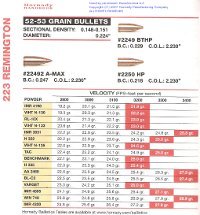 |
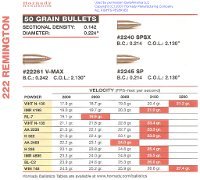 |
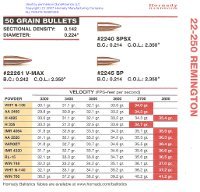 |
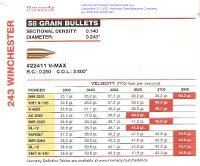 |
| 223 Remington | 222 Remington | 22-250 Remington | 243 Winchester |
| CLICK ON THE THUMBNAILS TO POP OUT THE FULL SIZE DATA PAGE | |||
|---|---|---|---|
As a practical application, what Superformance Varmint does (and for that matter all of the Superformance cartridges) is it puts another gun in your gun safe without having to go out and buy the other gun. You still have the old range of bullet weights and applications for your rifle, like using your .243 for deer and wild boar, or your .223 AR-15 for self defense and hunting applications, and a new application that is fantastic for prairie dog towns at 300 yards and beyond.
The reloading charts only tell half the story though. Muzzle velocity is a great apples to apples comparison of one particular load to another, but don’t forget the “other part of the story” with Hornady and Superformance ammunition. Terminal performance, splattering the prairie dog, is what true performance is about. That means you have to make a bullet that flies straight, resists the wind, and mushrooms properly when it hits said prairie dog. Ballistic coefficient (BC), a measured number that applies to any flying object regarding its wind resistance, may be about the most boring subject even the most hardened gun nut can discuss, but (most likely heavily caffeinated) Hornady engineers take it very seriously, and it was where some of these off the chart numbers are coming from.
If you take a look at these numbers I generated at Hornady’s excellent online ballistics calculator, you can compare the .223 Superformance (which uses a new 53 grain V-Max bullet) to a standard Hornady 55gr. V-Max in .223 and a 50gr. V-Max in .22-250, which is considered to be the most ideal varmint cartridge available. Look at the line for “Energy” at 300 yards and the “Trajectory” at the same difference. As you can see, a regular .223 doesn’t compare to the .22-250, but the Superformance Varmint .223 is a virtual match. the .290 BC of the new 53gr. V-Max bullet bucks the air more efficiently than the .242 BC, so retains more velocity and energy at 300 yards away critter.
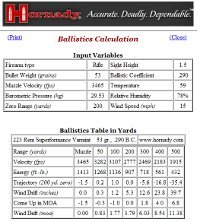 |
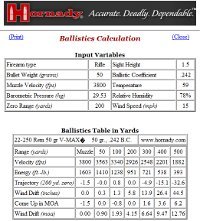 |
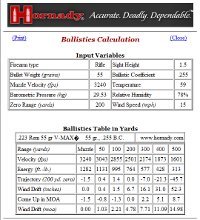 |
| 223 Superformance Varmint | 22-250 Remington | 223 Remington |
| CLICK ON THE THUMBNAILS TO POP OUT THE FULL SIZE DATA PAGE | ||
|---|---|---|
I say call a game changer a game changer. The fact that you can now fill up your .223 chambered AR-15 with Superformance .223 and lay waste to your friendly neighborhood prairie dog town with virtually no recoil at the performance of a .22-250, throwing fur 30 feet in the air 300 yards away, is a game changer. Hornady has done it again.
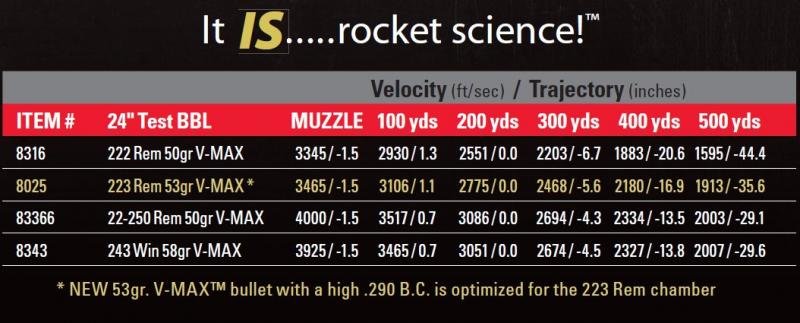
rdsii64, Just yesterday I was shooting my RRA predator pursuit with the 18 inch barrel and my chrony was reading an average of 3350 fps with the 53’s. Not the greatest group though, about 3/4 of an inch at 100 yds.
5spd I would love to know how you get 3400 fps from a 20″ barrel. I don’t doubt you, so dont take it the wrong way. I to have a 20″ AR15 and would love to get that kind of speed out of a 20″ barrel. I use vmax bullets as well. I just loaded the last of
my 50’s and am thinking of trying the 53’s
We have an article coming up on this and working on the data. The 53 clocks 3200 out of a 16″ M4.
I think Hornady really ought to look at the real world of AR users who shoot p-dogs as I have yet to see anyone who has a 24″ AR for p-dogs or other hunting needs as its just to heavy & bulky.
I dont think any of us real varmint shooters are going to waste $17 on a box of “super” ammo when our handloads perform better and way past 300 yards on targets from p-dogs to coyotes.
Sure it may be nice for a very limited round shooter & non reloader, thats about all.
I go through 400-600 rounds a day & average 9000 rounds a year just on varmints, no way am I going to buy that kind of ammo when my handloads cost fractions less using Hornady bullets also.
My own ARs have nothing more than a 20″ bbl & I have no problem & plenty of confidence shooting to 800 yards with them with my 50 vmaxloads at 3400 fps.
Please contrast the Hornady v-max and a-max bullet products specifically bullet construction
My interest is in coyote performance at 3200 to 3750 fps (with the
222 .223 22-250)
Thanks
T
my shooting prtnr has a good friend that’a been getting 3900 fps
out of his bolt action .223 mdl 700 with 26″ barrel using a faster
burning pwdr with no aparent signs of hi pressure.He’s using a 40g
vmax. I wont repeat the powder name for obvious reasons.. My
? is , will this pwd be available to handloaders. Buying 20 round
boxes of this new ammo would be quite expensive for me
considering the # of rounds I go thru on a 5 day prairie dog shoot.
I always felt that you could get more performance by mixing a fast-burning powder with a slow-burning powder. All the books frown on doing that as experimentation could be disastrous to the individual and the gun. I’m glad Hornady did it in a safe way. Now add some red dot and 4350 and away we go. Just kidding.
Guys, we are talking about shooting prarie dogs! I cannot believe an advertiser of ammunition would use the targeting of any animal as the benchmark for determing the usefulness of a specific round. Now, if you were using the targeting of terrorists, hard-core islamic fanatics as the benchmark then that would different; that would serve our national interests and would be okay by me. C’mon now!!!
Hi Derek. You are obviously not a hunter so you haven’t been exposed to the part of our sport that is tailored specifically for hunting needs. Pretty much every cartridge on the market that does not have a full metal jacket over a solid piece of lead is manufactured specifically to be effective on a specific type of game. If until now your exposure to firearms has been strictly self defense or military use then you might think that everything should be geared toward killing humans, but in fact most of our industry is driven by active target shooters (paper, metal plates, etc.) and hunters of all types of game. We are all gun enthusiasts and we should all respect and support each others interests. -ph@ga
touche
Derek, you have obviously never shot any type of target past 300 yards that reacts to ballistics. We have spent thousands of hours shooting past 300 yards in order to test different types of bullets and their performance. One example is when we shot full pop cans at 350 with the 223. Mostly just knocked them over and not much explosion or ripping of the can. Same distance with a 22-250, same bullet and turned the can into aluminum confetti. I don’t want to knock prairie dogs over i want the to blow up! Obviously, the more damage to a pop can or dog, the more damage to anything. Trust me. These bullets will be much worse on a terrorist than our military’s junk 62gr fmj steel core that tumbles on impact….key hole! Hornady is using these type of bullets in their TAP ammo for law enforcement. Lastly, you say “I cannot believe an advertiser of ammunition would use the targeting of any animal as the benchmark for determining the usefulness of a specific round.” Well, you’d better stop taking medication, using deodorant, shampoo, hand soap, or any type of chemical or substance used for the body because it was tested on rats to determine it’s usefulness on humans! Hornady knows their S**T and don’t just stand behind stuff because they think its a good idea. Their bullets help us make the most accurate rifles on earth! Love you Hornady! Every time i see a new shiny box of Hornady bullets come in, I get Hor-nady!
Hi Earl
If you read the first Part of the Article it says it all for your question:
“If you have ever considered hunting prairie dogs with your AR-15 platform rifle but thought the cartridge slightly underpowered for 300 yard dogtown decimation shots, you can now get close to .22-250 ballistics out of your .223 Remington chambered AR.” Seems like the answer to your question is Yes!
Cheers
Jeff
Yes, as far I we know the 53gr V-Max will be available to handloaders in the future, as all the other Hornady bullets that they put in their ammo are. As for the issues with your H-Bar, the 5.56 NATA chamber is not exactly the same as the .223 Rem chamber so the efficiency is not exactly the same when the case expands to fit the chamber. Hornady is such a classy company that they note that these numbers are tested in a .223 Rem chamber, even though most of the world doesn’t even know there are small internal differences between the .223 and the 5.56.
The mechanism issues are not issues. The fact that this is a SAAMI spec cartridge means that it will shoot just as reliably and with no more wear and tear on the gun than cheapo white box Wal-Mart ammo. -ph@ga
What you have not provided is the barrel length. This is really key to understanding the performance. Are we talking 24″ or 16″?
Hornady uses 24″ test barrels to determine the fps on all their cartridges. I saw that stated in one if their videos on their website.
not all of them
Will the “new” 53 grain VMax bullets be available for hand-loading? Is there any information on which powder was used, and will it be available on the market?
I answered this in a following post here. It is hard to get used to the differences in the blog and forum lol. -ph@ga
excellent
Dear Sirs,
Good article. Been handloading for 30 years. Never had a problem. Always read and follow directions.
V-Max sounds like a good idea in a bolt action or lever action rifle. In .223 I have some concerns. I have a COLT Hbar that I enjoy using. With every single factory load ever fired it has produced excellent on target accuracy. It has never had any sort of mechanical issue. Will V-Max .223 ammo work safely in my Hbar? The mechanism is designed with pressures and specifications of the military 5.56mm in mind. Will V-Max overdrive the mechanism of the AR-15 design?
Sincerely,
Earl
I answered this in a post instead of using the reply link here. Not used to the comments on this blog software. -ph@ga